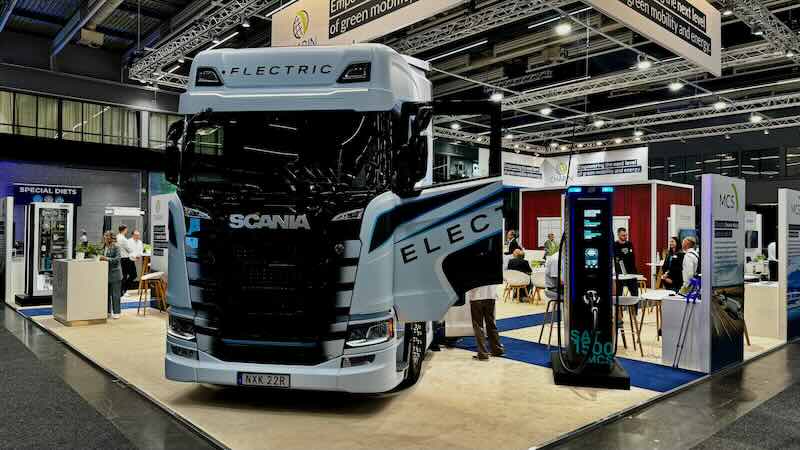One of the key topics discussed at EVS38 in Gothenburg last week was the use of electric vehicles in the heavy goods vehicle sector.
Europe is much further down the path of electrifying road freight than anywhere, apart from China. Electrified logistics is becoming increasingly prevalent, both for long and short routes, and it’s clear that, according to the theory of innovation, a ‘dominant design’ is emerging.
Multiple prime movers were on display from IVECO, Scania, Volvo and Daimler. A fairly standard cab-over design with 500 kWh of batteries and a Megawatt Charging System (MCS) charging port capable of 750 kW is emerging.
Hydrogen is a thing of the past; it’s no longer a factor, and the industry has been buying trucks approaching this specification for several years now.
At EVS, logistics operator DFDS was keen to talk about the 70 electric prime movers based at the Port of Gothenburg. They were an early adopter of electric trucks, partly because the Port of Gothenburg has been able to provide shore power to berthed ships for 25 years, making it easy to install the infrastructure to support truck charging.
This fleet is mainly focused on relatively short runs, where out-and-back journeys could be completed in a single charge.
Although back-to-base charging gets you going, it doesn’t get you far. Fast charging infrastructure is required to enable long-distance travel and better align charging with solar generation.
Daniel Speth of Fraunhofer Institute in Germany presented research showing that, although long-haul trucks would mainly be charged through 44 kW AC depot charging, there is a significant need for CCS charging (up to 350 kW) and MCS charging (up to 1 MW).
Since this charging will be focused on quick turnarounds in logistics hubs or en route, it will happen during the day and align well with solar generation.
MCS and CCS infrastructure rollout, supported by the EU, is well underway. Milence is a truck charging network co-owned by Volvo Group, Daimler Trucks and Traton, the latter of which owns Scania, MAN and VW trucks and buses. Milence used EVS to open the expansion of their charging location at Landvetter, just outside Gothenburg, and to launch their MCS product.
Europe seems to be set on battery trucks and high-powered charging. Why might this be the dominant design that has emerged? This is all designed around EU driver rest regulations, which require that every five hours, a driver must rest for 45 minutes.
Scania were showcasing the latest version of their prime mover with MCS charging. They claim a maximum range of 510 km with a gross train weight of 42 tonnes (the total mass of the prime mover and trailer) from their 560 kWh battery with usable capacity. This can be charged in 45 minutes using an MCS charger, which maximises the prime mover’s 750 kW charging capacity.
Given that most European countries limit articulated lorries to 40 tonnes GTW and a maximum speed of 80 or 90 km/h, you can see how Scania have a truck that can pull almost any load for the five hours between rest breaks, and charge the vehicle back up and be ready to go again after that break, even accounting for less-than-perfect range claims or increased consumption due to terrain or other factors.
This means that logistics companies can now operate EV trucks without compromising, maximising utilisation of two key assets: the prime mover and the driver.
So, how does this apply to Australia?
We have a very different attitude to driver fatigue management. In Australia, a driver must take a 15-minute continuous break during a five-and-a-half-hour driving block, which can be extended to six hours if the driver completes a ‘Basic Fatigue Management’ training module.
Leaving aside my newly found fear of motorway driving and whether these rules are appropriate for Australia, this puts us in a very different position with respect to road freight decarbonisation.
If the rest rules remain unchanged, charging would need to be significantly more powerful to deliver five to six hours of usable range in 15 minutes. I think I can safely say that no truck manufacturer is going to invest in this capability just to satisfy the needs of the small Australian truck market.
Scania and Volvo, however, are betting on charging trucks in Australia and have started to secure sales. Volvo secured a 30-truck prime mover order from Linfox back in May, but these could easily be used on routes with charging at one or both ends. Long-haul trucking may have three options.
Firstly, hydrogen has its proponents. Foton Mobility has been showcasing their hydrogen fuel cell-powered prime mover in videos on social media. It has just landed in Australia and is headed for ADR certification.
Battery swapping in Australia has been pioneered by Janus. More significantly, at the Melbourne EV meetup in May, Solar H2E announced their plans to import Sany trucks from China.
There are more than 100,000 of these battery-swapping prime movers on Chinese roads that use a vast network of automated battery-swap stations. Richard Zee of Solar H2E plans to have a demonstration truck in Australia within the next month, which he will also advance through ADR certification.
And it’s not just the battery that can be swapped. The system already has three swappable components: a prime mover, a driver and a trailer. As a shipper, you only care that your shipment gets there on time.
Imagine a world where a truck pulls into a rest stop when it runs out of power, unhooks from the trailer and goes off to charge. Another driver can then hook onto the load and continue the journey in a truck that is charged and ready to go. The driver could then take a subsequent load further down the road, or pick up a load that would take them home in the prime mover they arrived in, or in another charged and ready unit.
This isn’t a new idea; this is how stagecoaches worked before the advent of railways. However, it would transform the way trucking is operated today. Given that truck companies struggle to hire drivers due to the unsociable hours and nights away from home, it’s worth considering.
Whatever we try, Australia needs to accelerate the decarbonisation of our logistics sector — we’re far behind both Europe and China.

Ed Lynch-Bell is Principal at Second Mouse, dedicated to building more sustainable energy tech and mobility products, services and businesses. Ed is also a co-host of the Melbourne and Sydney EV Meet-ups, bringing the e-mobility industry together.


